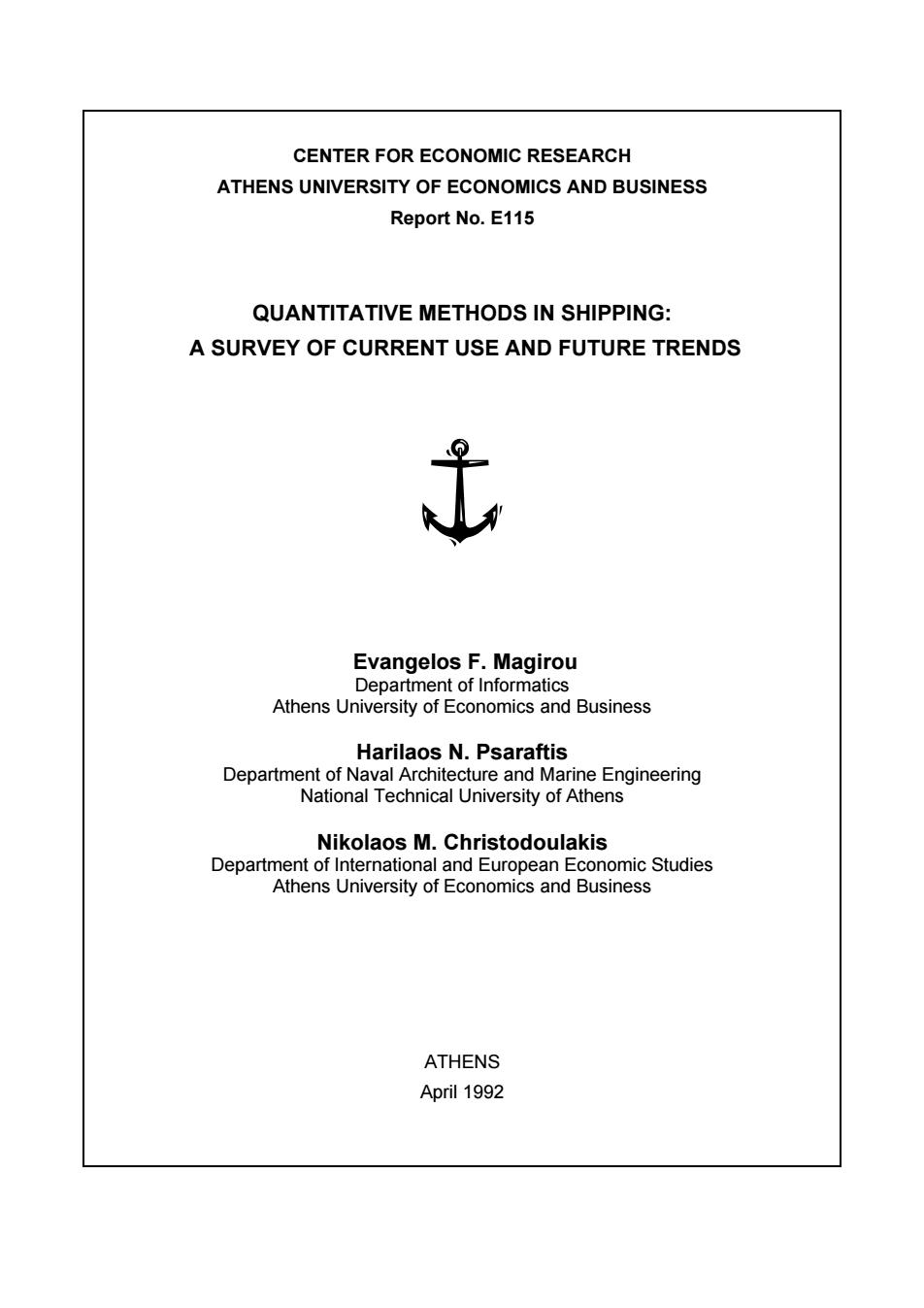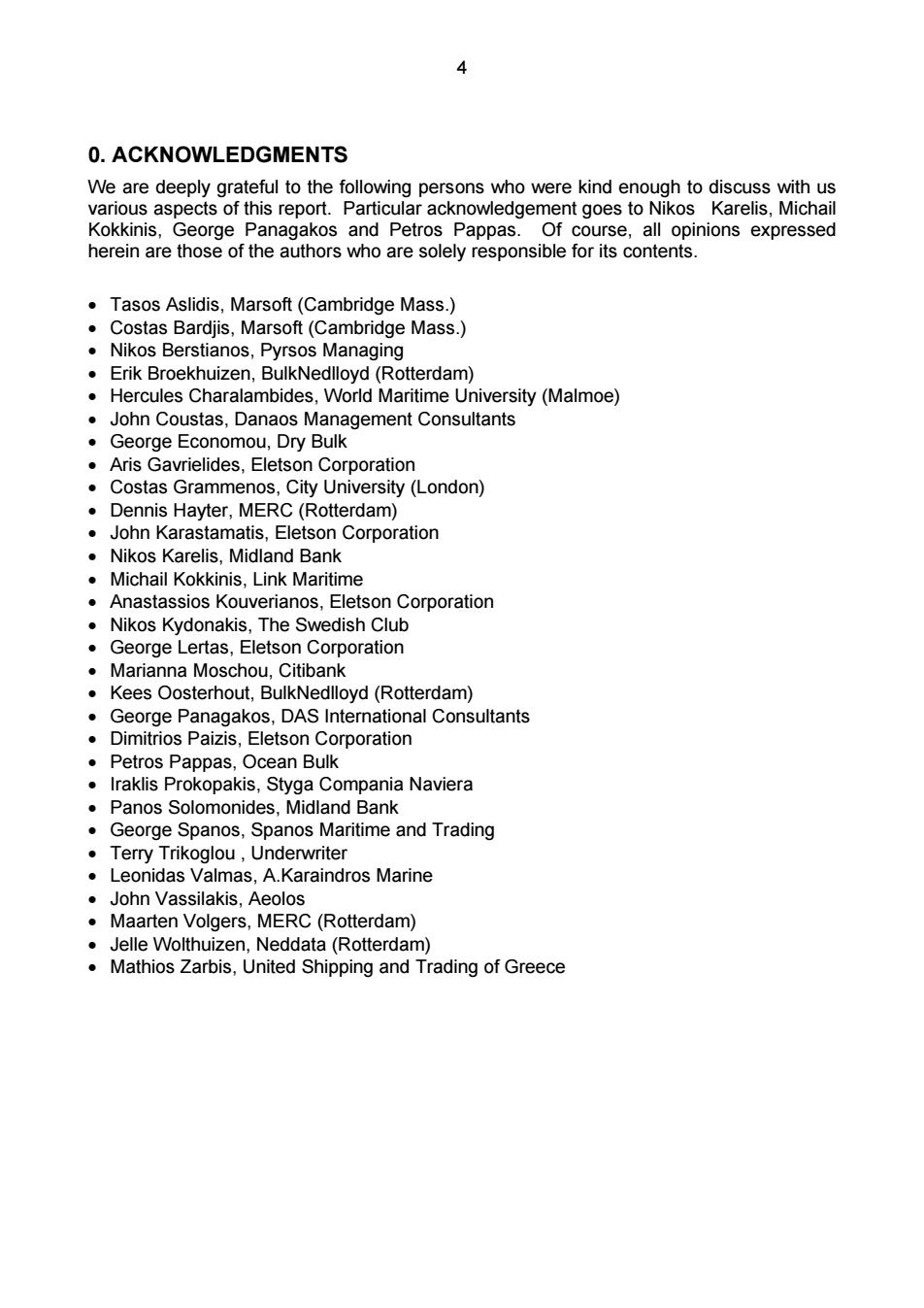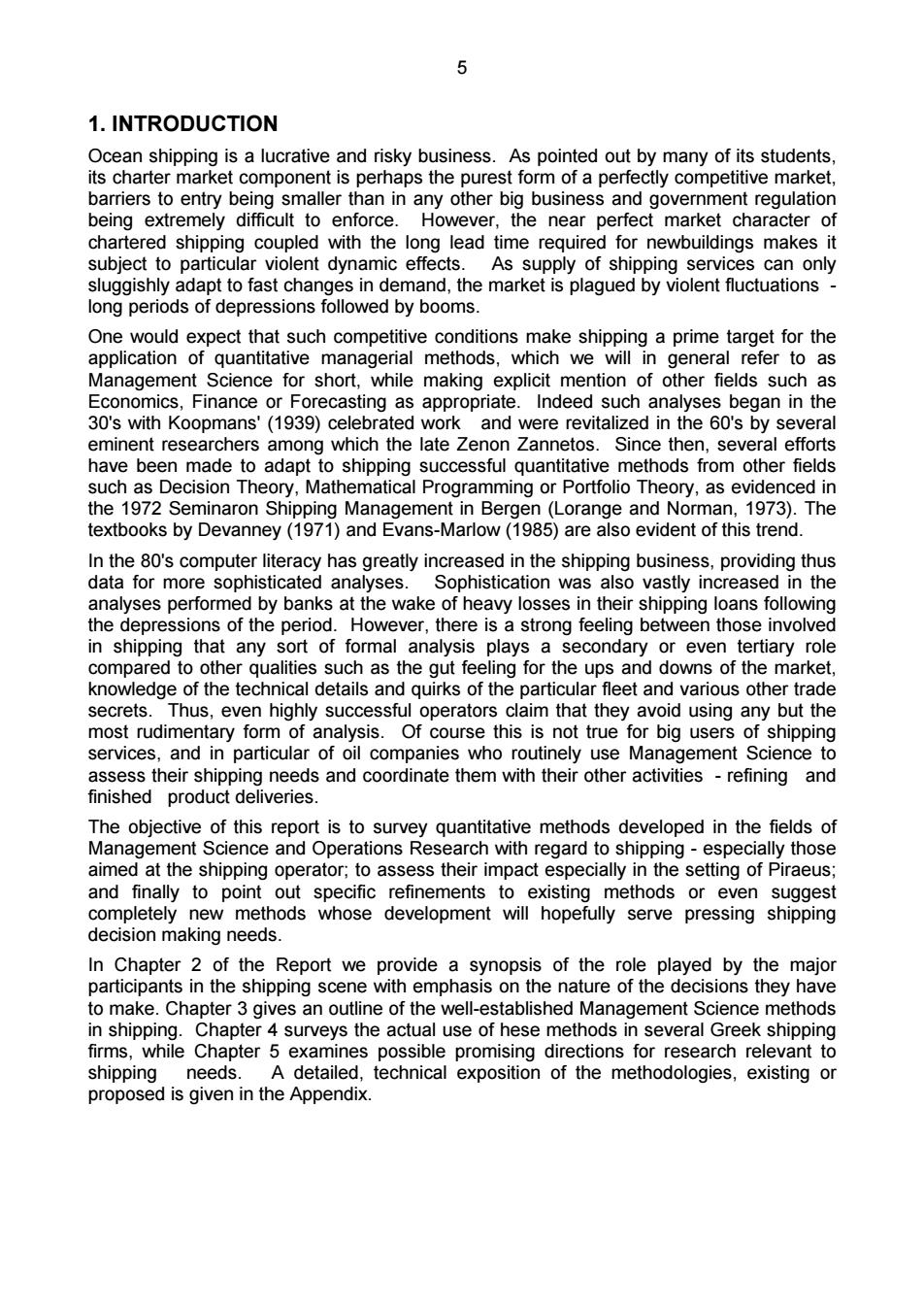
CENTER FOR ECONOMIC RESEARCH ATHENS UNIVERSITY OF ECONOMICS AND BUSINESS Report No.E115 QUANTITATIVE METHODS IN SHIPPING: A SURVEY OF CURRENT USE AND FUTURE TRENDS Evangelos F.Magirou Department of Informatics Athens University of Economics and Business Harilaos N.Psaraftis Department of Naval Architecture and Marine Engineering National Technical University of Athens Nikolaos M.Christodoulakis Department of International and European Economic Studies Athens University of Economics and Business ATHENS April 1992
CENTER FOR ECONOMIC RESEARCH ATHENS UNIVERSITY OF ECONOMICS AND BUSINESS Report No. E115 QUANTITATIVE METHODS IN SHIPPING: A SURVEY OF CURRENT USE AND FUTURE TRENDS Evangelos F. Magirou Department of Informatics Athens University of Economics and Business Harilaos N. Psaraftis Department of Naval Architecture and Marine Engineering National Technical University of Athens Nikolaos M. Christodoulakis Department of International and European Economic Studies Athens University of Economics and Business ATHENS April 1992

2 Table of Contents 0.ACKNOWLEDGMENTS 4 1.INTRODUCTION 5 2.THE MAJOR SHIPPING ACTIVITIES 6 2.1 SHIP OWNERS 6 2.2 CHARTERERS 8 2.3 BROKERS 8 2.4 BANKS 9 2.5INSURANCE 10 2.6 SHIPYARDS 11 2.7 THE SHIPPING SECTOR IN THE GREEK ECONOMY 11 3.A SURVEY OF EXISTING METHODS AND TOOLS 13 3.1 FORECASTING 13 3.2 FREIGHT RATE AS FUNCTION OF SUPPLY AND DEMAND 14 3.3 CHARTER MARKET DECISIONS UNDER UNCERTAINTY 15 3.4 INVESTMENT AND PORTFOLIO ANALYSIS 分 3.5 ACQUISITION STRATEGY-NEW BUILDINGS AND SECOND HAND 16 3.6 THE OPTIMUM SPEED OF SHIPS 17 3.7 WEATHER ROUTING 18 3.8 OPTIMAL LOADING PROBLEMS 18 3.9 MAINTENANCE AND REPLACEMENT 19 3.10 ROUTING,SCHEDULING,AND VESSEL POSITIONING 20 4.THE IMPACT OF QUANTITATIVE METHODS:THE PIRAEUS SCENE. 21 4.1 SHIPPING COMPANIES 21
2 Table of Contents 0. ACKNOWLEDGMENTS 4 1. INTRODUCTION 5 2. THE MAJOR SHIPPING ACTIVITIES 6 2. 1 SHIP OWNERS 6 2. 2 CHARTERERS 8 2. 3 BROKERS 8 2. 4 BANKS 9 2. 5 INSURANCE 10 2. 6 SHIPYARDS 11 2. 7 THE SHIPPING SECTOR IN THE GREEK ECONOMY 11 3. A SURVEY OF EXISTING METHODS AND TOOLS 13 3. 1 FORECASTING 13 3. 2 FREIGHT RATE AS FUNCTION OF SUPPLY AND DEMAND 14 3. 3 CHARTER MARKET DECISIONS UNDER UNCERTAINTY 15 3. 4 INVESTMENT AND PORTFOLIO ANALYSIS 15 3. 5 ACQUISITION STRATEGY - NEW BUILDINGS AND SECOND HAND 16 3. 6 THE OPTIMUM SPEED OF SHIPS 17 3. 7 WEATHER ROUTING 18 3. 8 OPTIMAL LOADING PROBLEMS 18 3. 9 MAINTENANCE AND REPLACEMENT 19 3. 10 ROUTING, SCHEDULING, AND VESSEL POSITIONING 20 4. THE IMPACT OF QUANTITATIVE METHODS: THE PIRAEUS SCENE. 21 4. 1 SHIPPING COMPANIES 21

3 4.2 BROKERS 22 4.3 BANKS 23 4.4 CHARTERERS 23 5.PROSPECTIVE DEVELOPMENTS 24 6.REFERENCES 27 7.APPENDIX 29 7.1 OPTIMAL SPEED OF SHIPS 29 7.2 CHARTER MARKET DECISIONS UNDER UNCERTAINTY 30 7.3 OPTIMAL POSITIONING 7.4 SHIP ACQUISITION POLICIES 31 7.5 PORTFOLIO ANALYSIS OF SHIPPING DECISIONS 32 7.6 CARGO SELECTION 32 7.7 OPTIMAL WORLD PETROLEUM FLOWS 33 7.8 WEATHER ROUTING 34 7.9 NEW DEVELOPMENTS IN FORECASTING AND ECONOMETRICS 7.9.1 Time-series Analysis and Forecasting. 515 7.9.2 Advances in Econometric modelling. 6
3 4. 2 BROKERS 22 4. 3 BANKS 23 4. 4 CHARTERERS 23 5. PROSPECTIVE DEVELOPMENTS 24 6. REFERENCES 27 7. APPENDIX 29 7. 1 OPTIMAL SPEED OF SHIPS 29 7. 2 CHARTER MARKET DECISIONS UNDER UNCERTAINTY 30 7. 3 OPTIMAL POSITIONING 31 7. 4 SHIP ACQUISITION POLICIES 31 7. 5 PORTFOLIO ANALYSIS OF SHIPPING DECISIONS 32 7. 6 CARGO SELECTION 32 7. 7 OPTIMAL WORLD PETROLEUM FLOWS 33 7. 8 WEATHER ROUTING 34 7. 9 NEW DEVELOPMENTS IN FORECASTING AND ECONOMETRICS 35 7. 9.1 Time-series Analysis and Forecasting. 35 7. 9.2 Advances in Econometric modelling. 36

0.ACKNOWLEDGMENTS We are deeply grateful to the following persons who were kind enough to discuss with us various aspects of this report.Particular acknowledgement goes to Nikos Karelis,Michail Kokkinis,George Panagakos and Petros Pappas.Of course,all opinions expressed herein are those of the authors who are solely responsible for its contents. Tasos Aslidis,Marsoft(Cambridge Mass.) .Costas Bardjis,Marsoft(Cambridge Mass.) Nikos Berstianos,Pyrsos Managing Erik Broekhuizen,BulkNedlloyd (Rotterdam) Hercules Charalambides,World Maritime University (Malmoe) John Coustas,Danaos Management Consultants George Economou,Dry Bulk Aris Gavrielides,Eletson Corporation Costas Grammenos,City University (London) Dennis Hayter,MERC(Rotterdam) John Karastamatis,Eletson Corporation .Nikos Karelis,Midland Bank Michail Kokkinis,Link Maritime Anastassios Kouverianos,Eletson Corporation Nikos Kydonakis,The Swedish Club George Lertas,Eletson Corporation Marianna Moschou,Citibank Kees Oosterhout,BulkNedlloyd (Rotterdam) George Panagakos,DAS International Consultants Dimitrios Paizis,Eletson Corporation Petros Pappas,Ocean Bulk Iraklis Prokopakis,Styga Compania Naviera Panos Solomonides,Midland Bank George Spanos,Spanos Maritime and Trading Terry Trikoglou,Underwriter Leonidas Valmas,A.Karaindros Marine John Vassilakis,Aeolos Maarten Volgers,MERC (Rotterdam) Jelle Wolthuizen,Neddata(Rotterdam) Mathios Zarbis,United Shipping and Trading of Greece
4 0. ACKNOWLEDGMENTS We are deeply grateful to the following persons who were kind enough to discuss with us various aspects of this report. Particular acknowledgement goes to Nikos Karelis, Michail Kokkinis, George Panagakos and Petros Pappas. Of course, all opinions expressed herein are those of the authors who are solely responsible for its contents. • Tasos Aslidis, Marsoft (Cambridge Mass.) • Costas Bardjis, Marsoft (Cambridge Mass.) • Nikos Berstianos, Pyrsos Managing • Erik Broekhuizen, BulkNedlloyd (Rotterdam) • Hercules Charalambides, World Maritime University (Malmoe) • John Coustas, Danaos Management Consultants • George Economou, Dry Bulk • Aris Gavrielides, Eletson Corporation • Costas Grammenos, City University (London) • Dennis Hayter, MERC (Rotterdam) • John Karastamatis, Eletson Corporation • Nikos Karelis, Midland Bank • Michail Kokkinis, Link Maritime • Anastassios Kouverianos, Eletson Corporation • Nikos Kydonakis, The Swedish Club • George Lertas, Eletson Corporation • Marianna Moschou, Citibank • Kees Oosterhout, BulkNedlloyd (Rotterdam) • George Panagakos, DAS International Consultants • Dimitrios Paizis, Eletson Corporation • Petros Pappas, Ocean Bulk • Iraklis Prokopakis, Styga Compania Naviera • Panos Solomonides, Midland Bank • George Spanos, Spanos Maritime and Trading • Terry Trikoglou , Underwriter • Leonidas Valmas, A.Karaindros Marine • John Vassilakis, Aeolos • Maarten Volgers, MERC (Rotterdam) • Jelle Wolthuizen, Neddata (Rotterdam) • Mathios Zarbis, United Shipping and Trading of Greece

5 1.INTRODUCTION Ocean shipping is a lucrative and risky business.As pointed out by many of its students. its charter market component is perhaps the purest form of a perfectly competitive market, barriers to entry being smaller than in any other big business and government regulation being extremely difficult to enforce.However,the near perfect market character of chartered shipping coupled with the long lead time required for newbuildings makes it subject to particular violent dynamic effects.As supply of shipping services can only sluggishly adapt to fast changes in demand,the market is plagued by violent fluctuations long periods of depressions followed by booms. One would expect that such competitive conditions make shipping a prime target for the application of quantitative managerial methods,which we will in general refer to as Management Science for short,while making explicit mention of other fields such as Economics,Finance or Forecasting as appropriate.Indeed such analyses began in the 30's with Koopmans'(1939)celebrated work and were revitalized in the 60's by several eminent researchers among which the late Zenon Zannetos.Since then,several efforts have been made to adapt to shipping successful quantitative methods from other fields such as Decision Theory,Mathematical Programming or Portfolio Theory,as evidenced in the 1972 Seminaron Shipping Management in Bergen(Lorange and Norman,1973).The textbooks by Devanney (1971)and Evans-Marlow(1985)are also evident of this trend. In the 80's computer literacy has greatly increased in the shipping business,providing thus data for more sophisticated analyses.Sophistication was also vastly increased in the analyses performed by banks at the wake of heavy losses in their shipping loans following the depressions of the period.However,there is a strong feeling between those involved in shipping that any sort of formal analysis plays a secondary or even tertiary role compared to other qualities such as the gut feeling for the ups and downs of the market, knowledge of the technical details and quirks of the particular fleet and various other trade secrets.Thus,even highly successful operators claim that they avoid using any but the most rudimentary form of analysis.Of course this is not true for big users of shipping services,and in particular of oil companies who routinely use Management Science to assess their shipping needs and coordinate them with their other activities -refining and finished product deliveries. The objective of this report is to survey quantitative methods developed in the fields of Management Science and Operations Research with regard to shipping-especially those aimed at the shipping operator;to assess their impact especially in the setting of Piraeus; and finally to point out specific refinements to existing methods or even suggest completely new methods whose development will hopefully serve pressing shipping decision making needs. In Chapter 2 of the Report we provide a synopsis of the role played by the major participants in the shipping scene with emphasis on the nature of the decisions they have to make.Chapter 3 gives an outline of the well-established Management Science methods in shipping.Chapter 4 surveys the actual use of hese methods in several Greek shipping firms,while Chapter 5 examines possible promising directions for research relevant to shipping needs.A detailed,technical exposition of the methodologies,existing or proposed is given in the Appendix
5 1. INTRODUCTION Ocean shipping is a lucrative and risky business. As pointed out by many of its students, its charter market component is perhaps the purest form of a perfectly competitive market, barriers to entry being smaller than in any other big business and government regulation being extremely difficult to enforce. However, the near perfect market character of chartered shipping coupled with the long lead time required for newbuildings makes it subject to particular violent dynamic effects. As supply of shipping services can only sluggishly adapt to fast changes in demand, the market is plagued by violent fluctuations - long periods of depressions followed by booms. One would expect that such competitive conditions make shipping a prime target for the application of quantitative managerial methods, which we will in general refer to as Management Science for short, while making explicit mention of other fields such as Economics, Finance or Forecasting as appropriate. Indeed such analyses began in the 30's with Koopmans' (1939) celebrated work and were revitalized in the 60's by several eminent researchers among which the late Zenon Zannetos. Since then, several efforts have been made to adapt to shipping successful quantitative methods from other fields such as Decision Theory, Mathematical Programming or Portfolio Theory, as evidenced in the 1972 Seminaron Shipping Management in Bergen (Lorange and Norman, 1973). The textbooks by Devanney (1971) and Evans-Marlow (1985) are also evident of this trend. In the 80's computer literacy has greatly increased in the shipping business, providing thus data for more sophisticated analyses. Sophistication was also vastly increased in the analyses performed by banks at the wake of heavy losses in their shipping loans following the depressions of the period. However, there is a strong feeling between those involved in shipping that any sort of formal analysis plays a secondary or even tertiary role compared to other qualities such as the gut feeling for the ups and downs of the market, knowledge of the technical details and quirks of the particular fleet and various other trade secrets. Thus, even highly successful operators claim that they avoid using any but the most rudimentary form of analysis. Of course this is not true for big users of shipping services, and in particular of oil companies who routinely use Management Science to assess their shipping needs and coordinate them with their other activities - refining and finished product deliveries. The objective of this report is to survey quantitative methods developed in the fields of Management Science and Operations Research with regard to shipping - especially those aimed at the shipping operator; to assess their impact especially in the setting of Piraeus; and finally to point out specific refinements to existing methods or even suggest completely new methods whose development will hopefully serve pressing shipping decision making needs. In Chapter 2 of the Report we provide a synopsis of the role played by the major participants in the shipping scene with emphasis on the nature of the decisions they have to make. Chapter 3 gives an outline of the well-established Management Science methods in shipping. Chapter 4 surveys the actual use of hese methods in several Greek shipping firms, while Chapter 5 examines possible promising directions for research relevant to shipping needs. A detailed, technical exposition of the methodologies, existing or proposed is given in the Appendix